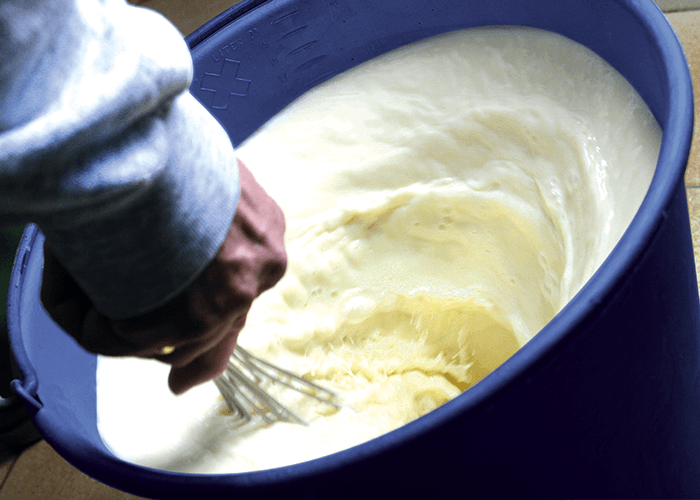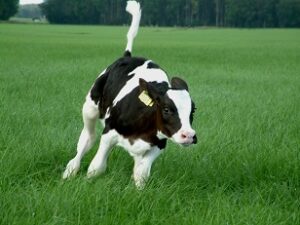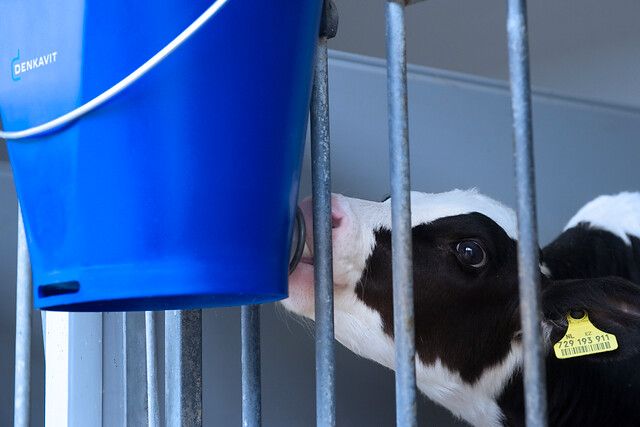Knowledge base theme ‘’Raw materials’’: what is actually in the calf milk replacer?
 In this series on the raw materials used in Denkamilk products we will explain a number of aspects in detail. This first part will focus on protein in milk products and the different dairy and vegetable sources that are available. A further article will focus on fats as well as the different additives that we use to support the digestibility of products and the health of the animals.
In this series on the raw materials used in Denkamilk products we will explain a number of aspects in detail. This first part will focus on protein in milk products and the different dairy and vegetable sources that are available. A further article will focus on fats as well as the different additives that we use to support the digestibility of products and the health of the animals.
Protein sources from dairy
The composition of a milk product should always consider the needs and digestive capacity of the animal. In this context the quality and the level of protein are very important. The protein in milk products provides the necessary amino acids to make body protein so that, for example, the organs and muscles can grow. The crude protein content in most calf milk replacers is between 19 and 24%. However, this figure says little about the quality of the protein. How well the animal can use this protein depends on the digestibility, the amino acid composition and the available energy from fat and carbohydrates. The apparent digestibility of the protein in a good milk product lies above 90%. For decades Denkavit has studied the digestibility of both dairy- and vegetable- derived raw materials for calves and lambs. So which protein sources are we talking about?
Most important dairy raw materials
Figure 1 shows the most important dairy raw materials and their relationship to each other. Whether or not a raw material is to a greater or lesser extent suitable for a high-grade milk product depends on the quality, digestibility and level of non-protein nitrogen (NPN). Raw materials such as skimmed milk powder (SMP) and whey powder concentrate (WPC) are very high quality protein raw materials with a similar amino acid composition and low NPN content. Both are often also used in products such as baby food and are also very suitable for milk products for our young animals.

Whey raw materials
There are many more types of dairy products within the category whey raw materials than just WPC. These raw materials vary greatly in protein-, ash- and NPN-content and, perhaps even more, in quality and digestibility. Due to this large variation in raw materials, knowledge about the different production processes and their effect on the animal is all the more important.
Whey permeate is a by-product of WPC production. WPC, compared with whey permeate, contains more protein and relatively less NPN. When whey permeate is used as a raw material for ruminants, it is important to compensate the difference in nutrient levels with other raw materials. Because whey permeate has a higher ash content, its taste is less appealing. This is an issue, especially when feeding it to young lambs and calves just after the colostrum. It is difficult to determine from a label if a milk product contains high quality raw materials or cheaper whey-type materials because whey raw materials are often all declared as whey powder. But there can be large differences between the types of whey raw materials used, also in their digestibility and quality. In the end, it’s the animals that indicate whether a milk product is good or not, but this can’t be read on a label.
SMP raw materials
Different products are also available in the SMP-category. These differ in origin as well as in quality. One of the most important quality characteristics of SMP is the quality of the coagulation. The main part of the protein in SMP, casein, can only be properly digested in the duodenum after it has clotted in the abomasum. When milk is drunk it passes through the first three stomachs intact and enters the abomasum. Due to the presence of acid and proteases, clotting happens here almost immediately.

One of these proteases is rennin, active at pH between 5 and 6, and crucial for the formation of the “cheese” (Figure 2). This enzymatic process cuts glyco-macropeptide out of the casein molecule so that it no longer remains as micellar protein in solution but precipitates out as curd. If the SMP in whole or in part does not clot properly in the abomasum, then undigested casein enters the small intestine intact.
This situation increases the risk of feed related digestive disorders, especially during the first weeks of the animal’s life. The ability of the SMP to coagulate well depends on the quality of the production process. Therefore, before the SMP can be processed into milk products it first has to be tested for clotting in our laboratory (Figure 3).
Clotting process
Of course, several factors play a role in the coagulation process in the abomasum of the animal. The percentage of SMP in the product, the concentration of the milk and the infection level on the farm all have a large impact. That’s why it is important to always have a good quality product, to use the right production procedure and ensure that the management of your animals is correct in order to prevent problems, such as during the clotting process.

In addition to dairy raw materials, vegetable raw materials are also used as a protein source in milk products. In the next article you will learn more about this interesting group of raw materials.
Do you have any questions after reading this article? Denkavit specialists are always available. Complete the form and we will contact you.








